




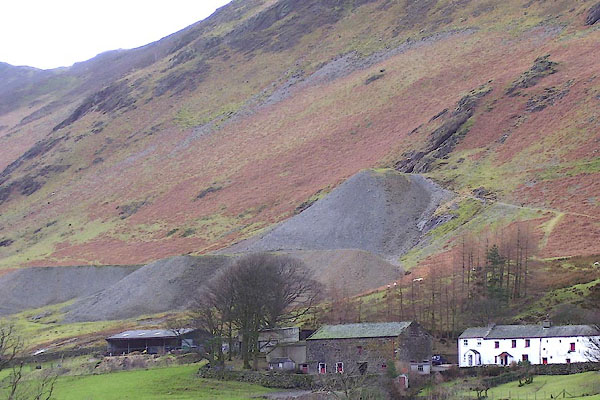
BOK70.jpg (taken 19.1.2008)
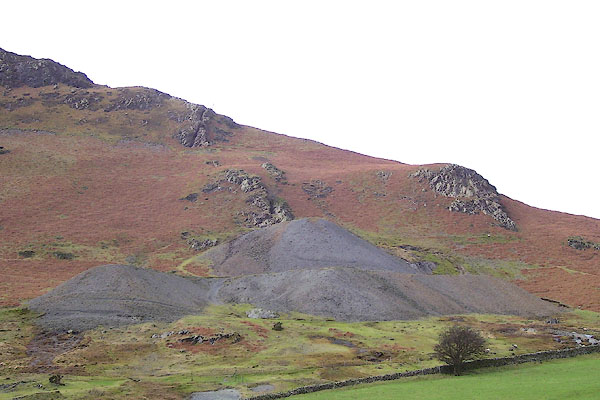
BOK71.jpg (taken 19.1.2008)
placename:- Goldscope
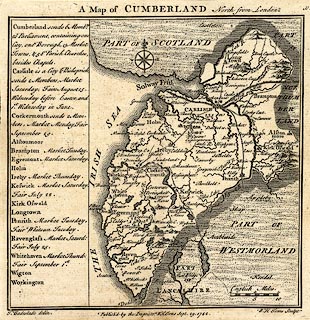 click to enlarge
click to enlargeBD10.jpg
"Copper Mines"
labelled W of Derwent Water
item:- JandMN : 115
Image © see bottom of page
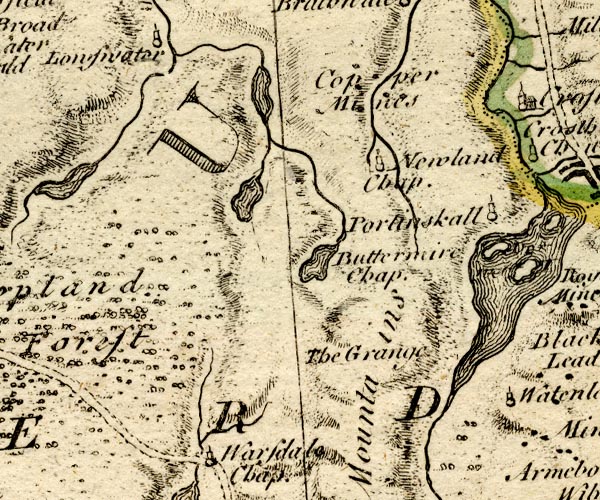
BO18NY11.jpg
"Copper Mines"
spots, by Newlands Beck
item:- Armitt Library : 2008.14.10
Image © see bottom of page
placename:- Gold Skop Copper Mines
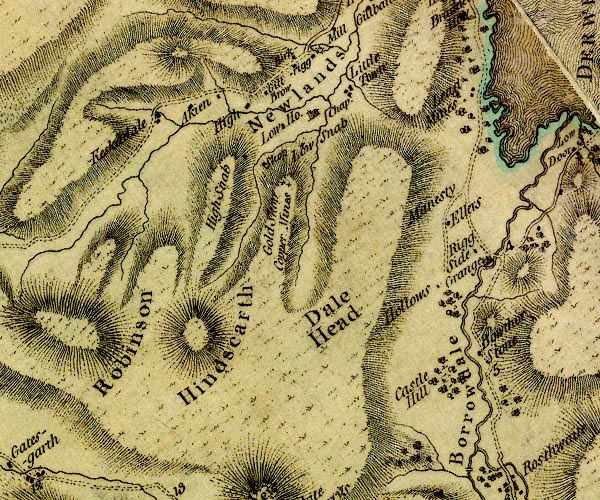
D4NY21NW.jpg
"Gold Skop Copper Mines"
crosses (+)

D4NY21NW.jpg
"Skop"
block or blocks, W of the ridge
item:- Carlisle Library : Map 2
Images © Carlisle Library
item:- copper; gold
 goto source
goto sourcePage 130:- "... But whoever takes a ride up Newland vale [1], will be agreeably surprised with some of the finest solemn pastoral scenes they have"
"[1] Here, in a hill called Gold-scope, are the remains of a famous ancient copper-mine, which exhibit some curious excavations, called the Pen-holes. One shaft, reaching from the top of the hill to the bottom (into which, if a large stone be let fall, it occasions a most tremendous noise) is met by a level passage, cut quite through the mountain, along which a stream of water (from Bank-beck) was conveyed to turn a draining wheel, at its meeting with the shaft."
"These mines were wrought in Henry 8th's time, and some of the succeeding reigns. But the metal yielding a considerable quantity of gold, they came to be considered as royal mines, and occasioned a dispute between the crown and the duke of Somerset, then lord of the manor, and a discontinuance of the works. In 1757, Mr. Gilbert and company drained them to the very bottom, at the expense of about 100l. but did not find the metal such, or so plentiful, as to encourage them to proceed on at so prodigious a depth."
"X."
 goto source
goto sourcePage 60:- "... Cambden, indeed, mentions, that copper mines were wrought in his time in New-Lands: he wrote in 1587, only two hundred years ago, yet not a vestige of tradition concerning any of these works can be traced. The Earl of Derwentwater is said to have drained this country of its inhabitants, many of whom perished, and the rest were afraid to return: yet surely some tradition might be expected; some old woman might tell her grand-children who it was that cut these subterraneous caverns. ..."
placename:- Goldscope
placename:- Gold Scalp
item:- copper; lead; gold; silver; Civil War
 goto source
goto sourcePage 85:- "..."
"It is not amiss, indeed, to take a ride into Newlands, to see Goldscope, or rather I would call it Gold-Scalp, and other places, where those once very valuable mines of copper were. Denton says they were wrought in King Henry the VIII's time: Nicholson and Burn say they were discovered in Queen Elizabeth's time by Thomas Thurland, and Daniel Hetchletter a German of Augsburg, (see Cambden, p.523.) which occasioned a suit between the Queen and Thomas then Earl of Northumberland, Lord of the Manor. In regard of the Queen's prerogative, (there being in these mines more gold and silver than copper or lead,) they were, by ancient law, the property of the Queen. Up in the Defendant's putting in a demurrer in law, it was agreed, that where the gold and silver extracted out of the copper or lead was of greater value than the copper or lead, it was then a Royal mine: But by the act 1st of William, no mine of copper, tin, lead, or iron shall from henceforth be deemed a Royal mine, provided that the gold or silver extracted be disposed of at the King's mint within the Tower of London: But smuggling of the metal arising to a great height, and disputes arising, another act was passed the 5th of William, cap. 6. wherein the owners of mines shall enjoy them; provided, nevertheless, that the King may have the ore of any mine, paying to the proprietors for the same, (the tin-ore within the counties of Devon and Cornwall excepted,) within thirty days after the ore shall be raised, and before it be removed, the following prices, viz. For every ton of copper sixteen pounds, for tin and iron forty shillings a ton, for every ton of lead nine pounds. Some authors say that these mines were then so valuable that they served the whole kingdom, and much of it was also exported. In the civil wars in 1650 and 1651 the smelting houses were destroyed, and most of the miners either killed or followed Oliver Cromwell: afterwards the Dutch, who came with William Prince of Orange, began the work again, and partly repaired the mills; the work was very rich, which caused the two acts before-mentioned to be passed, but the Dutch were driven from it in 1715, and it is now entirely lost, though Mr Gilberts has been lately at the expence of clearing the old level, but without effect."
placename:-
item:- copper; silver; gold
 goto source
goto sourcePage 170:- "..."
"... in which [Derwent Fells] at Newlands and elsewhere were rich veins of copper with some little gold and silver, opened afresh in our time by Thomas Thurland and Daniel Hotchstetter, a German, being well known before as appears from the Close rolls of Henry III. n. 18. A remarkable suit about them was carried on between the late queen Elizabeth and Thomas Percy earl of Northumberland, on whose estate the land was; but it was determined in favour of the queen, in regard of the royal prerogative and the veins of gold and silver in these mines. So far from truth is that observation of Cicero in his epistle to Atticus: "This is certain, that there is not a grain of silver in the whole island of Britain." Nor would Caesar have said, that the Britans imported all the copper they used, had he known of these mines, these copper works not only being sufficient for all England, but great quantities of the copper exported every year. ..."
item:- Civil War
 goto source
goto sourcePage 181:- "..."
"The rich copper mine at Newlands are said to have served all England and divers places beyond sea; but the works being destroyed and the miners killed in the civil war, they have never since been worked to any account."
item:- geology
 goto source
goto sourcePage 154:- "... A copper mine had formerly been worked to a great depth in a hill called Gold Scalp, in Newlands, and is said to have produced a very rich ore, which appears to have been a yellow sulphuret or copper pyrites. A little cobalt ore has been got in Newlands, and small quantities of manganese in various places. ..."
placename:- Goldscope Mine
item:- copper ore
 goto source
goto sourcepage 74:- "In 1561 a Company was incorporated for the purpose of working Goldscope and Dale Head Mines, where copper ore was found in great abundance. This was very probably the first Mining Company formed in the North of England, and undoubtedly the most aristocratic, as it was patronised by aldermen, noblemen, high officers of state, and even royalty itself. ..."
placename:- Goldscope Mine
placename:- Gowd Scalp Mine
item:- Gowd Scalp vein; Gold Scalp vein; Long Work vein; St Thomas's vein; Civil War; galena; copper pyrites; silver; gold
 goto source
goto sourcepage 76:- "GOLDSCOPE MINE."
"This mine is situated at the upper end of the Vale of Newlands, in a mountain bearing the same name. It embraces two lead veins, about sixty fathoms apart, which run nearly parallel to each other in a north-easterly and south-westerly direction; and a copper vein which runs east by north and west by south, and intersects the lead veins diagonally. The latter hades towards the south-east, and the former, south by east. The copper vein has contained rich deposits of ore, measuring in some places nine feet in thickness. The east, or Goldscope lead vein, has also been very rich in ore; it is an unusually large vein, varying from ten to fourteen feet in width, but although large and well mineralised below, it is so contracted and poor at the surface that it had almost entirely escaped the observation of the old miners. The west, or Sealby's vein, has also produced some ore, but it is much smaller than the east vein."
"The ores which these veins produce are galena and copper pyrites; the latter is very rich in silver, and also contains a small portion of gold, from which the mine has derived its name."
"Goldscope has been an important mine since the early part of the thirteenth century, being mentioned in the Close Rolls of Henry III., and in Gibson's Camden's Britannia ..."
 goto source
goto sourcepage 78:- "..."
"The quarrel between Queen Elizabeth and Earl Percy [over royal prerogative over the mine] culminated in armed rebellion by that nobleman, in which he was defeated and afterwards beheaded, and his head was exposed on one of the gates of York."
"In Robinson's Natural History of Westmorland and Cumberland, published in 1709, we are informed that "most of the judicious miners and chymists in England were concerned in the tryal, either as of the jury or evidence. The verdict was given for the Queen, and as the German books give account, a hundred tun of ore was entered upon by the Queen's agents.""
"Respecting the mine, he says, "In our survey of the mountains of Newlands we found eleven veins opened and wrought by the Germans; all distinguished by names given to them, as Gowd-Scalp, now Gold-Scalp, Long-Work, St. Thomas' Work, &c., of all which veins the richest was that they called Gowd-Scalp. We found the vein wrought three yards wide, and twenty fathoms deep above the grand level, which is driven in a hard rock a hundred fathom, and only with pick-axe, hammer, and wedge, the art of blasting with gunpowder being not then discovered. For securing of this rich vein, no cost of the best oak wood was spared; and for the recovering of the soles under the level was placed a water gin, and water was brought to it in troughs of wood upon the tops of high mountains, near half-a-mile from the vein.""
"This rich vein, and several more in the mountains of Newlands, are now laid open and recovered by his Grace the Duke of Somerset; and likewise smelt-houses, furnaces, and all other conveniences are made ready by his Grace for setting forward a great work. But it may be presumed that the discouragement his Grace met with, which at present hath put a stop to so noble a project, was his meeting with an ignorant operator, who, understanding not the nature of the ore, burnt and destroyed fifty tun of the best Gold-Scalp ore without the production of one pound of fine copper.""
"After the mine had been wrought continuously for about eighty-five years, it was closed abruptly by the civil wars in 1650 or 1651, and most of the miners were either killed or drafted into Cromwell's Army. ..."
 goto source
goto sourcepage 79:- "..."
"We must now pass over an interval of 130 years, of which there is no record; but it is most probable that the mine was closed during the greater part of that time. It was reopened by a private Company, consisting of William Clemence, senr., William Clemence, junr., John Bowden and John Floyd, to whom a lease was granted on the 10th March, 1847. The first-named gentleman acted as manager, and being of a very sanguine disposition, he proceeded to erect costly dressing machinery, and roasting furnaces, before ascertaining that there was sufficient ore to warrant the outlay. The result was that they were obliged to offer the mine for sale at the end of eighteen months, during which they had expended L5,000. It was purchased by another private Company, consisting of Andrew Richard Clarke, Charles Nicholas Patrick Chapman, George William Horn, and Thomas Hart; ..."
"This Company, instead of expending their capital upon machinery of doubtful utility, began to explore new ground, by driving forward the adit level (the "grand level" mentioned by Robinson), in search of fresh deposits of copper, and also pushed on the workings in the shaft below the level. They also opened an old lead mine, named Yewthwaite, about a mile and a half east of Goldscope."
"The success of Messrs. Clarke and Co. in raising copper was no greater than that of their predecessors; indeed up to November, 1850, they had only raised 32 tons 12 cwt., value ~137 10s. 7d.; the lead raised at Yewthwaite, prior to that date, was 35 tons 2 cwt., value L380 12s.; and the mines were in debt ~3,726 7s.4d. At this time the partnership was reduced to two; Mr. Hart became unable to contribute his quota of the working expenses, and his"
 goto source
goto sourcepage 80:- "share was forfeited on the 31st May, 1850. Two years later (23rd April, 1852), Mr. Chapman relinquished his shares, and sailed for Australia, hoping to find at the gold diggings the fortune he had failed to realize in the Newlands Mountains; ..."
"Mr. Clarke was now left to continue the struggle alone, and his unwavering perseverance was ultimately rewarded by the discovery of a deposit of ore, which far exceeded his highest expectations. This occurred in September, 1852. The adit level at Goldscope had been driven forward, along the Copper vein, about 60 fathoms from the old shaft; at this point the east Lead vein was cut, and a rich deposit of Lead ore discovered at the junction. The deposit of ore measured fifteen fathoms in length, and contained one rib of solid ore, three feet in thickness, besides three or four smaller ribs, varying from three to eight inches in thickness, and making a total of upwards of four feet of solid ore. After heading it out nearly to the surface, a height of 27 fathoms, a shaft was sunk, and the ore stoped out to the depth of 82 fathoms below the adit level. In the lower part of the mine the ore contracted to less than one-third of its former thickness, but its length increased to 45 fathoms."
"The amount of profit realized in stoping out the ore below the adit level, was about L25,000; and although there are no data available respecting the ground above the level, it is very probable that it would return a profit, almost, if not quite, equal to the amount realized below, as the produce of the vein above the adit level was more than three times greater, and the cost of cutting it much less than that below the level."
"..."
 goto source
goto sourcepage 81:- "The mine continued to return large profits for many years, but ultimately the shaft became so deep that the 40 feet water-wheel which pumped the water from it was no longer able to perform its allotted task; therefore, it became necessary either to expend a large sum of money in new and powerful machinery, or to abandon the mine; and as the executors, or rather trustees, were restrained by prudential considerations from risking their wards' money, the latter course was adopted, and the mine abandoned in 1864."
placename:- Goldscope Mine
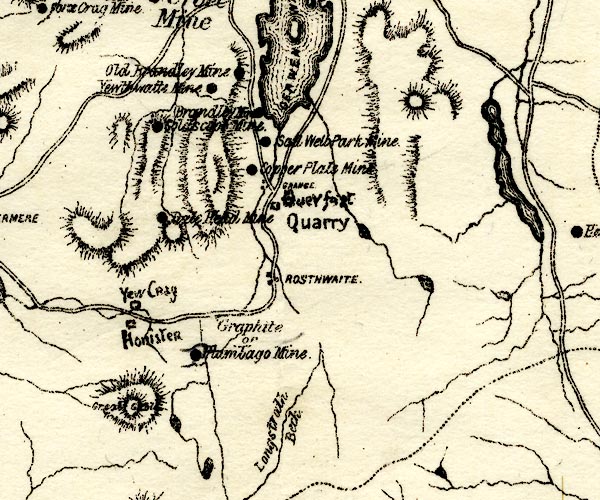
PST2NY21.jpg
"Goldscope Mine"
mine symbol
item:- JandMN : 162.2
Image © see bottom of page
placename:- Goldscope Mine
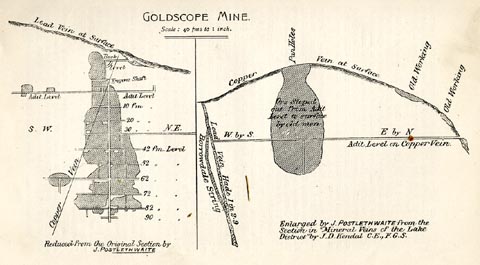 click to enlarge
click to enlargePST315.jpg
On p.77 of Mines and Mining in the English Lake District, by John Postlethwaite.
printed, lower left "Reduced from the Original Section by / J. POSTLETHWAITE"
printed, lower right "Enlarged by J. POSTLETHWAIRE from the / Section in "Mineral Veins of the Lake / District" by J. D. Kendal C.E., F.G.S."
printed, upper centre "GOLDSCOPE MINE. / Scale: 40 fms to 1 inch."
item:- JandMN : 162.17
Image © see bottom of page
placename:- Goldscope Mine
item:- copper ore
 goto source
goto sourcepage 74:- "In 1561 a Company was incorporated for the purpose of working Goldscope and Dale Head Mines, where copper ore was found in great abundance. This was very probably the first Mining Company formed in the North of England, and undoubtedly the most aristocratic, as it was patronised by aldermen, noblemen, high officers of state, and even royalty itself. ..."
placename:- Goldscope Mine
placename:- Gowd Scalp Mine
item:- Gowd Scalp vein; Gold Scalp vein; Long Work vein; St Thomas's vein; Civil War; galena; copper pyrites; silver; gold
 goto source
goto sourcepage 76:- "GOLDSCOPE MINE."
"This mine is situated at the upper end of the Vale of Newlands, in a mountain bearing the same name. It embraces two lead veins, about sixty fathoms apart, which run nearly parallel to each other in a north-easterly and south-westerly direction; and a copper vein which runs east by north and west by south, and intersects the lead veins diagonally. The latter hades towards the south-east, and the former, south by east. The copper vein has contained rich deposits of ore, measuring in some places nine feet in thickness. The east, or Goldscope lead vein, has also been very rich in ore; it is an unusually large vein, varying from ten to fourteen feet in width, but although large and well mineralised below, it is so contracted and poor at the surface that it had almost entirely escaped the observation of the old miners. The west, or Sealby's vein, has also produced some ore, but it is much smaller than the east vein."
"The ores which these veins produce are galena and copper pyrites; the latter is very rich in silver, and also contains a small portion of gold, from which the mine has derived its name."
"Goldscope has been an important mine since the early part of the thirteenth century, being mentioned in the Close Rolls of Henry III., and in Gibson's Camden's Britannia ..."
 goto source
goto sourcepage 78:- "..."
"The quarrel between Queen Elizabeth and Earl Percy [over royal prerogative over the mine] culminated in armed rebellion by that nobleman, in which he was defeated and afterwards beheaded, and his head was exposed on one of the gates of York."
"In Robinson's Natural History of Westmorland and Cumberland, published in 1709, we are informed that "most of the judicious miners and chymists in England were concerned in the tryal, either as of the jury or evidence. The verdict was given for the Queen, and as the German books give account, a hundred tun of ore was entered upon by the Queen's agents.""
"Respecting the mine, he says, "In our survey of the mountains of Newlands we found eleven veins opened and wrought by the Germans; all distinguished by names given to them, as Gowd-Scalp, now Gold-Scalp, Long-Work, St. Thomas' Work, &c., of all which veins the richest was that they called Gowd-Scalp. We found the vein wrought three yards wide, and twenty fathoms deep above the grand level, which is driven in a hard rock a hundred fathom, and only with pick-axe, hammer, and wedge, the art of blasting with gunpowder being not then discovered. For securing of this rich vein, no cost of the best oak wood was spared; and for the recovering of the soles under the level was placed a water gin, and water was brought to it in troughs of wood upon the tops of high mountains, near half-a-mile from the vein.""
"This rich vein, and several more in the mountains of Newlands, are now laid open and recovered by his Grace the Duke of Somerset; and likewise smelt-houses, furnaces, and all other conveniences are made ready by his Grace for setting forward a great work. But it may be presumed that the discouragement his Grace met with, which at present hath put a stop to so noble a project, was his meeting with an ignorant operator, who, understanding not the nature of the ore, burnt and destroyed fifty tun of the best Gold-Scalp ore without the production of one pound of fine copper.""
"After the mine had been wrought continuously for about eighty-five years, it was closed abruptly by the civil wars in 1650 or 1651, and most of the miners were either killed or drafted into Cromwell's Army. ..."
 goto source
goto sourcepage 79:- "..."
"We must now pass over an interval of 130 years, of which there is no record; but it is most probable that the mine was closed during the greater part of that time. It was reopened by a private Company, consisting of William Clemence, senr., William Clemence, junr., John Bowden and John Floyd, to whom a lease was granted on the 10th March, 1847. The first-named gentleman acted as manager, and being of a very sanguine disposition, he proceeded to erect costly dressing machinery, and roasting furnaces, before ascertaining that there was sufficient ore to warrant the outlay. The result was that they were obliged to offer the mine for sale at the end of eighteen months, during which they had expended L5,000. It was purchased by another private Company, consisting of Andrew Richard Clarke, Charles Nicholas Patrick Chapman, George William Horn, and Thomas Hart; ..."
"This Company, instead of expending their capital upon machinery of doubtful utility, began to explore new ground, by driving forward the adit level (the "grand level" mentioned by Robinson), in search of fresh deposits of copper, and also pushed on the workings in the shaft below the level. They also opened an old lead mine, named Yewthwaite, about a mile and a half east of Goldscope."
"The success of Messrs. Clarke and Co. in raising copper was no greater than that of their predecessors; indeed up to November, 1850, they had only raised 32 tons 12 cwt., value ~137 10s. 7d.; the lead raised at Yewthwaite, prior to that date, was 35 tons 2 cwt., value L380 12s.; and the mines were in debt ~3,726 7s.4d. At this time the partnership was reduced to two; Mr. Hart became unable to contribute his quota of the working expenses, and his"
 goto source
goto sourcepage 80:- "share was forfeited on the 31st May, 1850. Two years later (23rd April, 1852), Mr. Chapman relinquished his shares, and sailed for Australia, hoping to find at the gold diggings the fortune he had failed to realize in the Newlands Mountains; ..."
"Mr. Clarke was now left to continue the struggle alone, and his unwavering perseverance was ultimately rewarded by the discovery of a deposit of ore, which far exceeded his highest expectations. This occurred in September, 1852. The adit level at Goldscope had been driven forward, along the Copper vein, about 60 fathoms from the old shaft; at this point the east Lead vein was cut, and a rich deposit of Lead ore discovered at the junction. The deposit of ore measured fifteen fathoms in length, and contained one rib of solid ore, three feet in thickness, besides three or four smaller ribs, varying from three to eight inches in thickness, and making a total of upwards of four feet of solid ore. After heading it out nearly to the surface, a height of 27 fathoms, a shaft was sunk, and the ore stoped out to the depth of 82 fathoms below the adit level. In the lower part of the mine the ore contracted to less than one-third of its former thickness, but its length increased to 45 fathoms."
"The amount of profit realized in stoping out the ore below the adit level, was about L25,000; and although there are no data available respecting the ground above the level, it is very probable that it would return a profit, almost, if not quite, equal to the amount realized below, as the produce of the vein above the adit level was more than three times greater, and the cost of cutting it much less than that below the level."
"..."
 goto source
goto sourcepage 81:- "The mine continued to return large profits for many years, but ultimately the shaft became so deep that the 40 feet water-wheel which pumped the water from it was no longer able to perform its allotted task; therefore, it became necessary either to expend a large sum of money in new and powerful machinery, or to abandon the mine; and as the executors, or rather trustees, were restrained by prudential considerations from risking their wards' money, the latter course was adopted, and the mine abandoned in 1864."
placename:- Goldscope Mine

PST2NY21.jpg
"Goldscope Mine"
mine symbol
item:- JandMN : 162.2
Image © see bottom of page
placename:- Goldscope Mine
 click to enlarge
click to enlargePST315.jpg
On p.77 of Mines and Mining in the English Lake District, by John Postlethwaite.
printed, lower left "Reduced from the Original Section by / J. POSTLETHWAITE"
printed, lower right "Enlarged by J. POSTLETHWAIRE from the / Section in "Mineral Veins of the Lake / District" by J. D. Kendal C.E., F.G.S."
printed, upper centre "GOLDSCOPE MINE. / Scale: 40 fms to 1 inch."
item:- JandMN : 162.17
Image © see bottom of page
placename:- Goldscope Mine
item:- copper pyrites; bornite; malachite; galena; arsenic pyrites (?); gypsum
Geological Outing of the Kendal and District Mine Research Society
Log book page 4:- "DATE - SUNDAY 8/4/79 / MAP REF - NY21 2270 1840 / LOCATION - NEWLANDS VALLEY / NAME - GOLDSCOPE MINE / TYPE OF SITE - MINE / WORKING OR DISUSED - DISUSED / PEOPLE IN PARTY [ ] / NOS. OF PHOTOS - No.2 / SPECIMENS FOUND - COPPER PYRITES WITH SOME SMALL AMOUNTS OF BORNITE. / COMMENTS - MINE VERY DRY, VERY LITTLE WATER MOVEMENT. SECOND SET OF STOPES COLLAPSED IN PLACES, SINCE LAST VISIT IN 1978. ENTRANCE TO LOWER LEVELS NOW BLOCKED AND APPEARS TO BE RATHER DANGEROUS TO TRY AND DIG RUBBLE AWAY, AS ONE VERY LARGE (APPROX 8'X8') BOULDER IS LYING ON TOP OF IT. NICE BAND OF STAIN MALACHITE FORMED MOSTLY BY WATER, CAN BE SEEN HIGH UP IN SECOND SET OF STOPES."
Log book page 24:- "DATE - 22/7/79 SUNDAY / MAP REF - 2270/1840 / LOCATION - NEWLANDS VALLEY / NAME - GOLDSCOPE MINE / TYPE OF SITE - MINE / WORKING OR DISUSED - DISUSED / PEOPLE IN PARTY [ ] / NOS. OF PHOTOS - Nos 2 / SPECIMENS FOUND - COPPER PYRITES, GALENA BORNITE POSSIBLY ARSENICAL PYRITES. / COMMENTS - NICE DRY DAY. MINE AS LAST VISITED EXCEPT EVEN DRIER."
Log book page 43:- "DATE - SUNDAY 16/12/79 / MAP REF - / LOCATION - / NAME - / TYPE OF SITE - / WORKING OR DISUSED - / PEOPLE IN PARTY [ ] / NOS. OF PHOTOS - / SPECIMENS FOUND - FLORETS OF GYPSUM CRYSTALS BUT WERE TO (sic) FRAGILE TO BRING OUT. / COMMENTS - SUNNY DRY DAY, (BUT COLD WIND). FOUND A WAY PAST LARGE BOULDER &RUBBLE AND CRAWLED ABOUT 10-15YDS, TO WHERE TUNNEL IS STANDING HEIGHT AGAIN. FOLLOWING THIS TUNNEL FOR APPROX 60-70 YDS ONE ENCOUNTERS A FORK, THE TUNNEL AHEAD ENDS IN ROOF FALL, BUT LEFT FORK CARRIES ON, UNTIL ANOTHER FORK, (LEFT), IS MET WITH. TAKE THIS LEFT FORK AS TUNNEL AHEAD ENDS IN ROOF FALL. THE ROOF IN THE LEFT FORK IS VERY LOW AND CRAWLING IS NESS. UNTIL TUNNEL BECOMES STANDING HEIGHT AGAIN. 20YDS AFTER STANDING UP, TUNNEL ENDS IN ROCK FACE."
otherwise:- "AS PAGE 4 &24"
Log book pages 94-95:- "DATE - 28/6/81 / MAP REF - GENERAL AREA 2230/1840 / LOCATION - DERWENTWATER FELLS, HIGH CRAGS / NAME - GOLDSCOPE TRIALS ? / TYPE OF SITE - MINES/TRIALS. / WORKING OR DISUSED - DISUSED. / PEOPLE IN PARTY [ ] / NOS. OF PHOTOS - 55. / SPECIMENS FOUND - GALENA, COPPER PYRITES &ARSENIC PYRITES / COMMENTS - DRY WARM DAY. WORKINGS ARE SPREAD UP BOTH SIDES OF THE VALLEY, MAINLY LEAD WORKINGS. AT THE HEAD OF THE VALLEY IS THE OLD DAM BUILT FOR WATER STORAGE FOR USE BY GOLDSCOPE MINES AT THE BOTTOM OF THE VALLEY. QUITE A FEW LEVELS EXIST ON THE S. SIDE OF THE VALLEY, BUT ONLY ONE EXTENDS FOR ANY DISTANCE. THIS ONE LEVEL IS QUITE OLD, SUGGESTED BY THE RAILS WHICH ARE WOODEN. THREE OR FOUR POCKETS OF ORE (LEAD_ HAVE BEEN STOPED OUT, AND THE LEAD VEIN CAN BE FOLLOWED THROUGHOUT MOST OF THE LEVEL. AT GOLDSCOPE MINE SEVERAL SHAFTS CAN BE SEEN IN WHAT THE ORDNANCE SURVEY LISTS AS A QUARRY? ONE OF THESE SHAFTS SEEMS TO DECEND (sic) FOR APPROX 350 FT, POSSIBLY INTO THE OLD LEAD WORKINGS. THE SPOIL HEAPS AT THE BACK OF GOLDSCOPE CONTAIN QUITE A LARGE AMOUNT OF COPPER PYRITES AND SOME HANSOME (sic) SPECIMENS WERE FUND. THE MAIN LEVELS INTO GOLDSCOPE, ON THIS SIDE OF HIGH CRAGS, ARE BLOCKED. ACCESS IS OBTAINED ON THE OTHER SIDE OF THE CRAGS BUT NONE LEAD INTO THE SHAFTS MENTIONED ABOVE, OLD LEAD WORKINGS. SEE 8/4/79. SEE 22/7/79 SEE 16/12/79."
Log book page 105:- "DATE - 7/3/82 / MAP REF - / LOCATION - / NAME - GOLDSCOPE TRIALS ?? / TYPE OF SITE - / WORKING OR DISUSED - / PEOPLE IN PARTY [ ] / NOS. OF PHOTOS - 55 / SPECIMENS FOUND - / COMMENTS - AS 28/6/81 + . WARM DAY, TWO MORE TRAILS WERE FOUND TODAY ONE OF WHICH SEEMS TO BE WORTHWHILE EXPLORING ONCE THE DEEP WATER HAS BEEN DRAINED OFF. THE OTHER IS COMPLETELY FULL OF WATER AND WITH LITTLE CHANCE OF DRAINING IT, SEEMS TO BE VERY UNSUITABLE."
otherwise:- "AS 28/6/81"
item:- private collection : 82
Image © see bottom of page
placename:- Goldscope Mine
placename:- Goldscope Trial
 click to enlarge
click to enlargeKMR22.jpg
"GOLDSCOPE MINE"
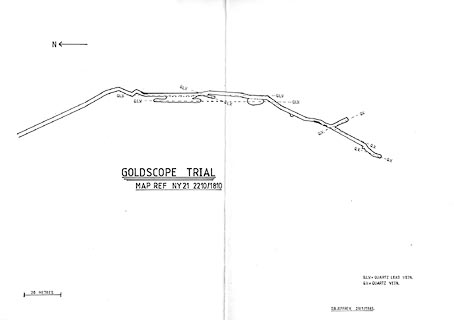 click to enlarge
click to enlargeKMR23.jpg
"GOLDSCOPE TRIAL"
item:- private collection : 82
Image © see bottom of page
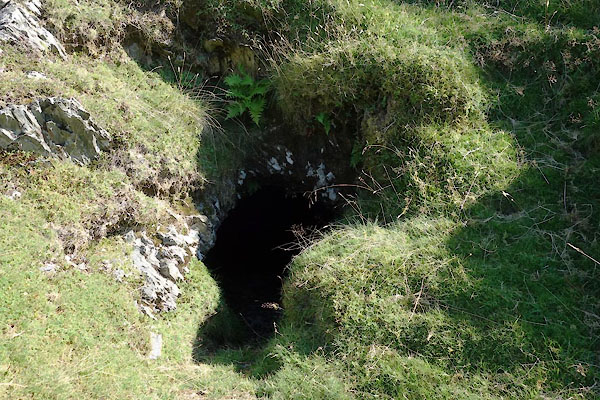
BZG69.jpg Level,
(taken 6.9.2013)
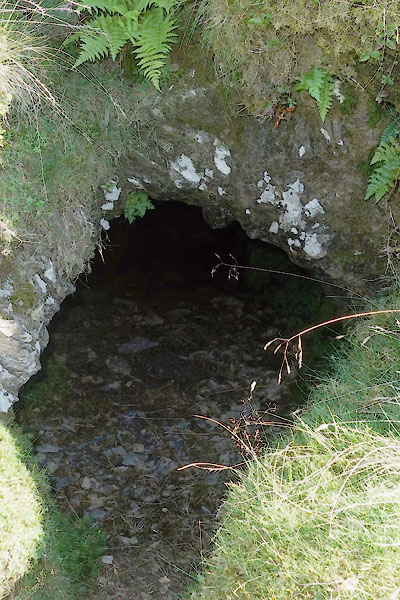
BZG70.jpg Level,
(taken 6.9.2013)
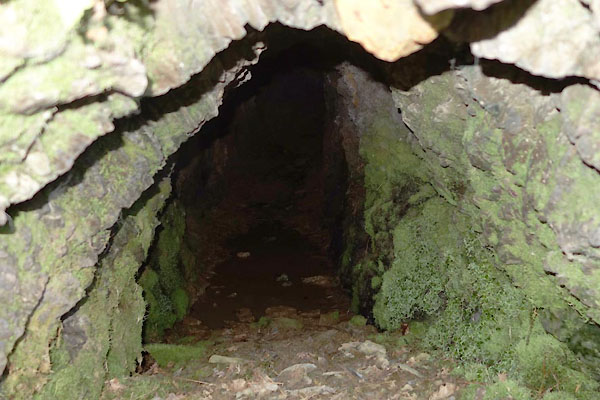
BZG71.jpg Level,
(taken 6.9.2013)
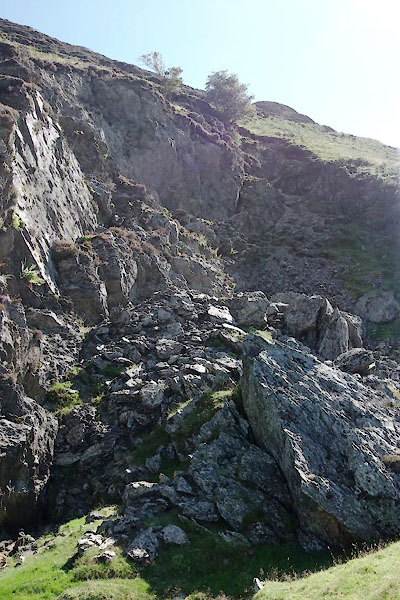
BZG72.jpg Quarry?
(taken 6.9.2013)

BZG73.jpg Level,
(taken 6.9.2013)
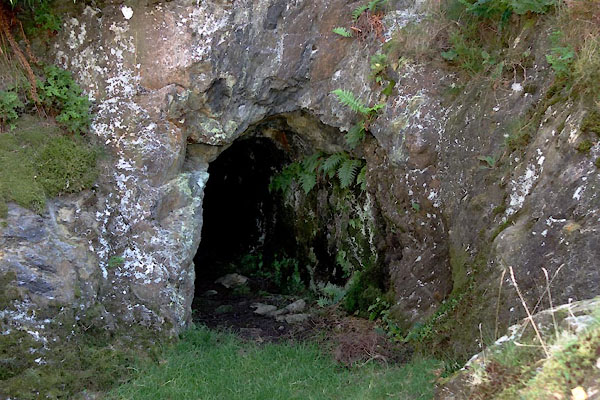
BZG74.jpg Level,
(taken 6.9.2013)
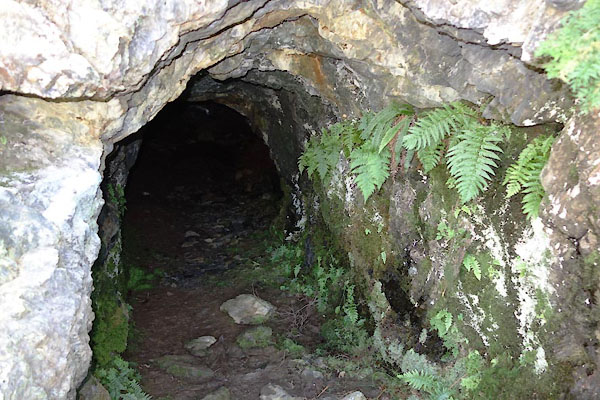
BZG75.jpg Level,
(taken 6.9.2013)

BZG77.jpg Grand Level,
(taken 6.9.2013)
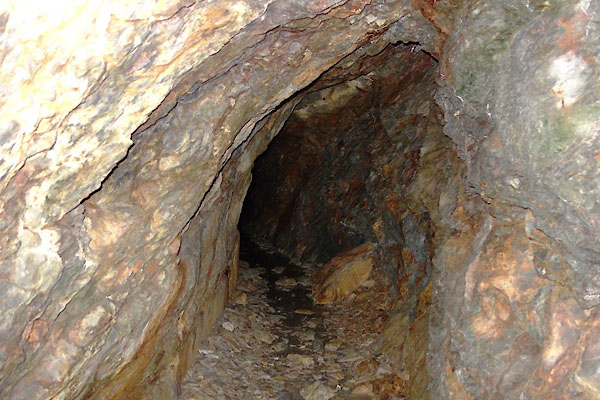
BZG78.jpg Grand Level,
(taken 6.9.2013)

BZG79.jpg Grand Level,
(taken 6.9.2013)
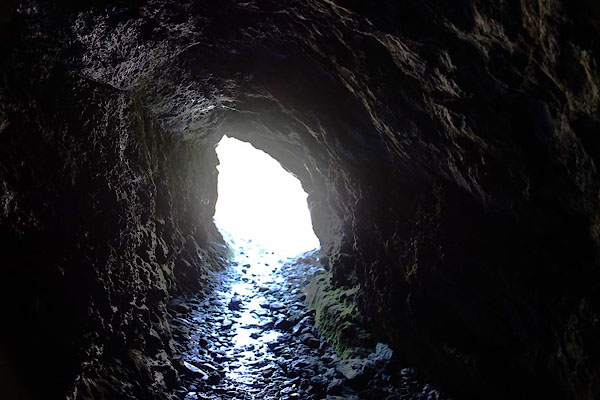
BZG80.jpg Grand Level,
(taken 6.9.2013)
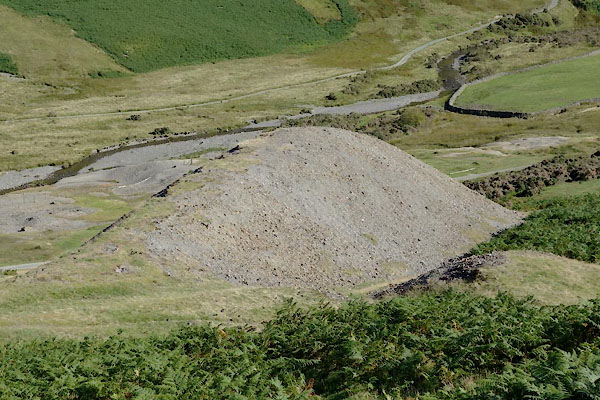
BZG81.jpg Spoil heap.
(taken 6.9.2013)

BZG82.jpg Spoil heap.
(taken 6.9.2013)
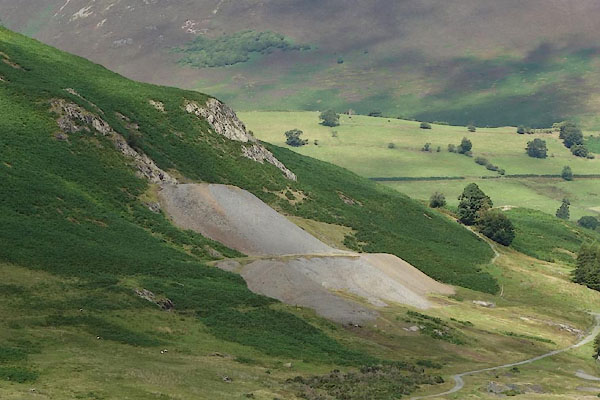
CBJ24.jpg Spoil heap.
(taken 4.8.2014)

Click to enlarge
CBJ25.jpg Spoil heap.
(taken 4.8.2014)
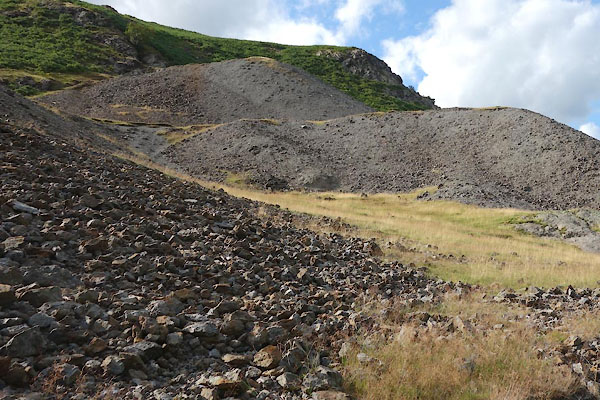
CBJ26.jpg Spoil heap.
(taken 4.8.2014)
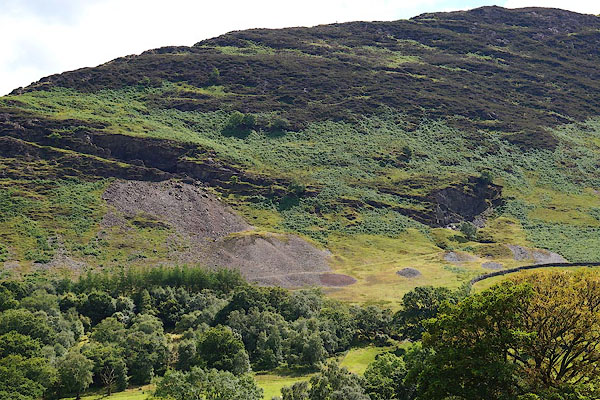
CBA87.jpg (taken 9.7.2014)

CBA88.jpg (taken 9.7.2014)
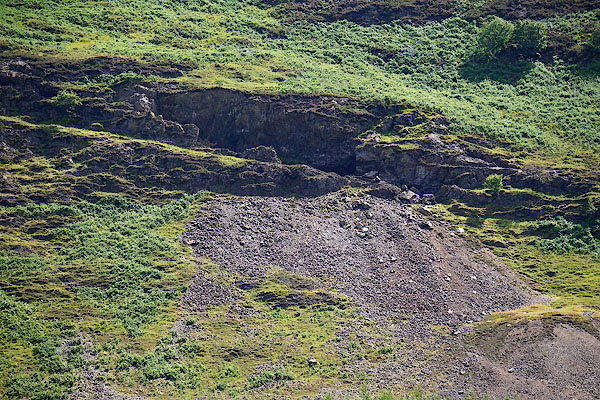
CBA89.jpg (taken 9.7.2014)
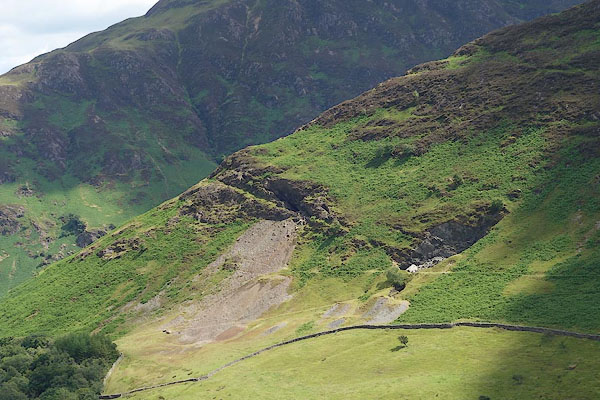
CBB15.jpg (taken 9.7.2014)
Adams, John: 1988: Mines of the Lake District Fells: Dalesman Books (Lancaster, Lancashire):: ISBN 0 85206 931 6
